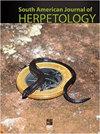Potential Distribution of Plestiodon copei (Squamata: Scincidae), an Endemic and Threatened Lizard of Mexico
IF 0.7
4区 生物学
Q4 ZOOLOGY
引用次数: 0
Abstract
Abstract. Species distribution models are increasingly important in herpetological studies of spatial ecology and conservation. In this paper, we estimate the potential distribution of an endemic and threatened Mexican lizard, Plestiodon copei. The presence of this skink was estimated using the maximum entropy algorithm, and the most relevant environmental variables for the model were identified. Additionally, the specialization of the species was evaluated, the coverage of natural protected areas throughout its distribution was estimated, and the priority areas for the conservation of this lizard were delimited. The model shows that the optimum areas of distribution extend from the southeastern state of Jalisco within the Faja Volcánica Transmexicana (FVT) to the limits of the states of Puebla and Veracruz, covering an area of approximately 12,300 km2. The distribution of P. copei was associated with high mountains and temperate forests, ecosystems strongly affected by human activities. The model predicted previously unrecorded populations, some of which were corroborated in the field. It was also found that 53.08% of the species' distribution is within natural protected areas along the FVT. These observations emphasize the urgent need to propose conservation strategies for this endemic lizard and its habitat.一种墨西哥特有的濒危蜥蜴——桡Plestiodon copei(Squamata:Scincidae)的潜在分布
摘要物种分布模型在空间生态学和保护的爬虫学研究中越来越重要。在这篇论文中,我们估计了一种地方性的和受威胁的墨西哥蜥蜴——桡Plestiodon copei的潜在分布。使用最大熵算法估计了这种skink的存在,并确定了与模型最相关的环境变量。此外,还对该物种的专业化进行了评估,估计了整个分布过程中自然保护区的覆盖范围,并确定了保护这种蜥蜴的优先区域。该模型显示,最佳分布区域从墨西哥东南部哈利斯科州的法贾火山(FVT)延伸到普埃布拉州和韦拉克鲁斯州的边界,面积约为12300平方公里。copei的分布与高山和温带森林有关,这些生态系统受到人类活动的强烈影响。该模型预测了以前未记录的人口,其中一些在实地得到了证实。研究还发现,53.08%的物种分布在FVT沿线的自然保护区内。这些观察结果强调了迫切需要为这种地方性蜥蜴及其栖息地提出保护策略。
本文章由计算机程序翻译,如有差异,请以英文原文为准。
求助全文
约1分钟内获得全文
求助全文
来源期刊
CiteScore
1.50
自引率
0.00%
发文量
10
期刊介绍:
The South American Journal of Herpetology (SAJH) is an international journal published by the Brazilian Society of Herpetology that aims to provide an effective medium of communication for the international herpetological community. SAJH publishes peer-reviewed original contributions on all subjects related to the biology of amphibians and reptiles, including descriptive, comparative, inferential, and experimental studies and taxa from anywhere in the world, as well as theoretical studies that explore principles and methods.

 求助内容:
求助内容: 应助结果提醒方式:
应助结果提醒方式:


